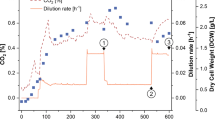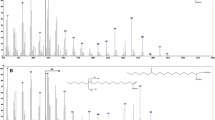Abstract
The lipid compositions of Chlorobium limicola (4 strains) and Chloroflexus aurantiacus (2 strains) have been compared. Both species contained straight-chain, saturated and monosaturated fatty acids as their main fatty acid constituents but the patterns were distinctly different. Chlorobium contained acids of chain-length essentally in the range C12−C18 with n-tetradecanoate, hexadecenoate and n-hexadecanoate predominating. Chloroflexus was characterized by the presence of significant amounts of C17 and C18−C20 fatty acids not detected in Chlorobium. The latter, on the other hand, contained hydroxylated and cyclopropane-substituted acids not detected in Chloroflexus. Simple wax esters (C28−C38) were found solely in Chloroflexus and accounted for 2.5–3.0% of the cell dry weight. Their fatty acid constituents ranged from C12−C19 (both saturated and monounsaturated isomers) whereas the alcohols were generally saturated and of chain-length C16−C19. Waxes in the range C34−C36 accounted for more than 60% of the total.
The polar lipid patterns of the two genera also showed marked differences. All strains contained phosphatidyl-glycerol, monogalactosyl diglyceride and sulfoquinovosyldiglyceride. Chlorobium contained in addition cardiolipin, phosphatidylethanolamine, the unidentified “glycolipid II” and several other unidentified glycolipids, whereas phosphatidyl inositol and a diglycosyl diglyceride were specific for Chloroflexus. The latter lipid contained equimolar amounts of glucose and galactose.
Phenol-water extraction yielded material comprising 14% of the dry cell weight for Chlorobium but only 2.5% for Chloroflexus. The Chlorobium material contained two 3-hydroxy fatty acids and several uncommon sugars (not identified). The analytical results were inconclusive regarding occurrence of 2-keto-3-deoxyoctonate. No typical lipopoly-saccharide constituents were found in Chloroflexus.
Similar content being viewed by others
Abbreviations
- CL:
-
cardiolipin; cy, cyclopropane
- DGDG:
-
digalactosyl diglyceride
- g.l.c.:
-
gas-liquid chromatography
- LPS:
-
lipopolysaccharide
- MGDG:
-
monogalactosyl diglyceride
- OH:
-
hydroxy
- PE:
-
phosphatidyl ethanolamine
- PG:
-
phosphatidyl glycerol
- PI:
-
phosphatidyl inositol
- SQDG:
-
sulfoquinovosyl diglyceride
- IFA:
-
trifluoroacetyl
- t.l.c.:
-
thin-layer chromatography
- TMS:
-
trimethylsilyl
References
Bacchin P, Robertiello A, Viglia A (1974) Identification of n-decane produced in Corynebacterium cultures by combined gas chromatography-mass spectrometry. Appl Microbiol 28:737–741
Bligh EG, Dyer WJ (1959) A rapid method of total lipid extraction and purification. Can J Biochem. Physiol 37:911–917
Brian BL, Gardner EW (1968) A simple procedure for detecting the presence of cyclopropane fatty acids in bacterial lipids. Appl Microbiol 16:549–552
Broch-Due M, Ormerod JG (1978) Isolation of a Bchl c mutant from Chlorobium with Bchl d by cultivation at low light intensity. FEMS Micobiol Lett 3:305–308
Bryn K, Jantzen E (1982) Analysis of lipopolysaccharides by methanosilica trifluoroacetylation, and gas chromatography on a fusedsilica capillary column. J Chromatogr 240:405–413
Bryn K, Jantzen E, Bøvre K (1977) Occurrence and patterns of waxes in Neisseriaceae. J Gen Microbiol 102:33–43
Christie WW, Noble RC, Moore JH (1970) Determination of lipid classes by a gas-chromatographic procedure. Analyst 95:940–944
Constantopoulos G, Bloch K (1967) Isolation and characterization of glycolipids from some photosynthetic bacteria. J Bacteriol 93:1788–1793
Cronan JE, Randall R, Taylor FR, Jackson MB (1979) Properties and biosynthesis of cyclopropane fatty acids in E. coli. J Bacteriol 138:118–121
Cruden DL, Stanier RY (1970) The characterization of Chlorobium vesicles and membranes isolated from green bacteria. Arch Mikrobiol 72:115–134
Dittmer JC, Wells MA (1969) Quantitative and quantitative analysis of lipids and lipid components. In: Lövenstein JM (ed) Methods in enzymology, Vol XIV. Academic Press, New York London, pp 482–530
Drøge W, Lehmann V, Lüderitz O, Westphal O (1970) Structural investigations on the 2-keto-3-deoxyoctonate region of lipopolysaccharides. Eur J Biochem 14:175–184
Fox GE, Stackebrandt E, Hespell RB, Gibson J, Maniloff J, Dyer TA, Wolfe RS, Balch WE, Tanner RS, Magrum LJ, Zablen LB, Blakemore R, Gupta R, Bonen L, Lewis BJ, Stahl DA, Luehrsen KR, Chen KN, Woese CR (1980) The phylogeny of the procaryotes. Science 209:457–463
Gallagher IH (1971) Occurrence of waxes in Acinetobacter. J Gen Microbiol 68:245–247
Jantzen E, Bryn K, Hagen T, Bergan T, Bøvre K (1978) Fatty acids and monosaccharides of Neisseriaceae in relation to established taxonomy. NIPH Annals (Oslo) 1:59–71
Kates M (1975) Techniques of lipidology. Isolation, analysis and identification of lipids. North Holland Publishing Company, Amsterdam, pp 558–559
Kenyon CN (1978) Complex lipids and fatty acids of photosynthetic bacteria. In: Clayton RK, Sistrom WR (eds) The photosynthetic bacteria. Plenum Press, New York, pp 281–310
Kenyon CN, Gray AM (1974) Preliminary analysis of lipids and fatty acids of Green bacteria and Chloroflexus aurantiacus. J Bacteriol 120:131–138
Madigan MT, Petersen RT, Brock TD (1974) Nutritional studies on Chloroflexus, a filamentous, photosynthetic, gliding bacterium. Arch Microbiol 100:97–103
Pfennig N (1961) Eine vollsynthetische Nährlösung zur selektiven Anreicherung einiger Schwefelpurpurbakterien. Naturwissenschaften 48:136
Pierson BK, Castenholz RW (1974) Studies on pigments and growth in Chloroflexus aurantiacus, a phototrophic filamentous bacterium. Arch Microbiol 100:283–305
Radwan SS (1978) Coupling of two-dimensional thin layer chromatography with gas chromatography for the analysis of lipid classes and their constituent fatty acids. J Chromatog Sci 6:538–542
Rosenberg M, Perry A, Bayer EA, Gutnick D, Rosenberg E, Ofek I (1981) Adherence of Acinetobacter calcoaceticus RAG-1 to human epithelial cells and to hexadecane. Infect Immun 33:29–33
Sharkey AG, Friedel RA, Langer SH (1957) Mass spectra of trimethylsilyl derivatives Anal Chem 29:770–776
Sirevåg R (1974) Further studies on carbon dioxide fixation in Chlorobium. Arch Microbiol 98:3–13
Staehelin LA, Golecki JR, Fuller RC, Drews G (1978) Visualization of supramolecular architecture of chlorosomes (Chlorobium-type vesicles) in freeze-fractured cells of Chloroflexus aurantiacus. Arch Microbiol 119:269–277
Westphal O, Jann K (1965) Bacterial lipopolysaccharides. Extraction with phenol-water and further applications of the procedure. In: Whistler RL (ed) Methods in carbohydrate chemistry, vol V. General Polysaccharides, Academic Press, New York, pp 83–91
Author information
Authors and Affiliations
Rights and permissions
About this article
Cite this article
Knudsen, E., Jantzen, E., Bryn, K. et al. Quantitative and structural characteristics of lipids in Chlorobium and Chloroflexus . Arch. Microbiol. 132, 149–154 (1982). https://doi.org/10.1007/BF00508721
Received:
Accepted:
Issue Date:
DOI: https://doi.org/10.1007/BF00508721




